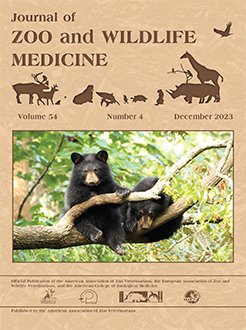Cownose rays (Rhinoptera bonasus) are common elasmobranchs in zoos and aquaria; however, there is a lack of published information regarding ocular findings in this species. Intraocular pressure (IOP) was measured in a total of 52 cownose rays (Rhinoptera bonasus) from two unrelated aquaria (n = 22 from A1, n = 30 from A2) using a TonoVet rebound tonometer on two settings (dog = D, and unidentified species = P) as part of a full ophthalmologic examination. Adult (n = 38) and juvenile (n = 14) rays were sampled out of water briefly in sternal recumbency. Intraocular pressure (mean ± SD [range]) in the D setting (9.10 ± 2.57 [4–18] mmHg) was higher than the P setting (5.21 ± 2.32 [0–12] mmHg) (P<0.001). Statistical analysis revealed no difference in IOP between right and left eyes, and no correlation between body weight and IOP. No differences in IOP between sex, age group, and location were identified in either setting. However, a significant difference was observed between levels of severity of corneal disease in IOP D setting (P=0.006) and P setting (P=0.024), and levels of severity of intraocular disease in IOP D setting (P=0.034) only. This study provides baseline IOP values using rebound tonometry in aquarium-housed cownose rays with apparent corneal and intraocular lesions and reveals that the D setting may be more sensitive in identifying IOP changes in eyes with intraocular disease.
How to translate text using browser tools
9 January 2024
INTRAOCULAR PRESSURES OF AQUARIUM-HOUSED COWNOSE RAYS (RHINOPTERA BONASUS) WITH NORMAL AND ABNORMAL OPHTHALMIC EXAMS
Laura Martinelli,
Braidee C. Foote,
Xiaojuan Zhu,
James G. Johnson III,
Jared Durrett,
Chris Buckner,
Julie D. Sheldon
ACCESS THE FULL ARTICLE





